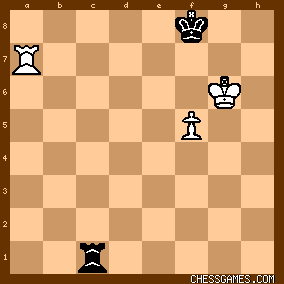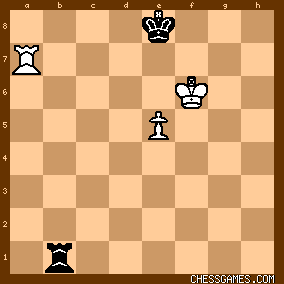| Oct-10-07 | | Sleeping kitten: 61...♖f1! draws and it is the only move, e.g. 62.♔f6 ♔g8! 63.♖a8+ ♔h7 64.♖f8 ♖a1 65.♖d8 ♖f1! and White can't progress. It is an elementary rook endgame and ♖f1 should be the kind of move one plays with hardly thinking. It is incredible to see a player who was strong enough to meet Alekhine and Capa (and even to beat Marshall!) blundering in such a canonical position. |
|
| May-15-12 | | LoveThatJoker: Guess-the-Move Final Score:
Capablanca vs I Turover, 1931.
YOU ARE PLAYING THE ROLE OF CAPABLANCA.
Your score: 145 (par = 122)
LTJ |
|
Jan-29-15
 | | Eggman: The position after 61.Kg6:

click for larger viewActually, 61...Rf1 is not the only move to draw; there is also 61...Rg1+, since after 62.Kf6 Kg8 63.Ra8+ Kh7 64.Kf7 Black can play 64...Rb1, when he has sufficient checking distance, e.g. 65.f6 Rb7+ 66.Ke6 Rb6+ 67.Ke7 Rb7+ 68.Kd6 Rb6+ 69.Ke7 Rb7+ 70.Kf8 Kg6, etc. Meanwhile if we take the above position and move everything one file to the left, like so: 
click for larger view... then <Sleeping kitten>'s method (61...Re1!) is the only viable option, since after 61...Rf1+ 62.Ke6 Kf8 63.Ra8+ Kg7 64.Ke7 Rb1 Black lacks sufficient checking distance, and White wins routinely: 65.e6 Rb7+ 66.Kd6 Rb6+ 67.Kd7 Rb7+ 68.Kc6 Rb1 69.e7, etc. |
|
Jan-29-15
 | | Eggman: <<It is incredible to see a player who was strong enough to meet Alekhine and Capa (and even to beat Marshall!) blundering in such a canonical position.>> Early days. It's not the only time that Capablanca won a rook and pawn vs rook ending against world-class opposition: Capablanca vs Menchik, 1929. And in fact, against Menchik, Capablanca also misplayed the position, throwing away the win before having it handed back to him! |
|
May-06-15
 | | Phony Benoni: You can argue that, say, Korchnoi or Averbakh might have played the rook ending a bit better than Turover. But at least he knew the rules of chess about castling! |
|
May-07-15
 | | Benzol: <PB> LOL. For those not in the know see the kibitzing on the game Averbakh vs Purdy, 1960 :) |
|
Mar-14-19
 | | GrahamClayton: Capablanca's only tournament game in the database where he played Bird's Opening as White - the other 14 games are either simultaneous games or casual games. |
|
| Mar-14-19 | | JimNorCal: As PB notes, this game is worth playing over just to view Black's 24th move. |
|
| Aug-30-23 | | Albion 1959: Whatever happened to when the pawns are on the same side it is draw? Even with a one pawn majority. This must be the one game in a hundred where this is the exception and the other 99 were drawn? |
|
Aug-31-23
 | | beatgiant: <Albion 1959> See the previous kibitzing. It was a book draw until Black blundered on move 61. |
|
Aug-31-23
 | | keypusher: <beatgiant: <Albion 1959> See the previous kibitzing. It was a book draw until Black blundered on move 61.> I'm curious how well R+P endgames were known back then. Fine's book hadn't been written, obviously. Was there a standard reference in those days, in English or German? |
|
Aug-31-23
 | | perfidious: <keypusher>, not to my knowledge; BCE was only published after World War II, the seminal work on rook endings by Levenfish and Smyslov in the 1950s, and I believe Keres' monograph only became widely available in the mid 1970s. Remember seeing all of them at the local club by 1975. |
|
Aug-31-23
 | | beatgiant: At the time this game was played, the standard reference was Berger's Theorie und Praxis der Endspiele (in German). It would have covered the Lucena position, the Philidor position, and a few other special cases such as rook and extra rim pawn versus rook, but I'm not sure if it had the specific technique needed here. |
|
Aug-31-23
 | | beatgiant: To play for the Philidor position, Black could have refrained from ceding the 6th rank with 46...Re7, instead playing any king move or a rook move along the 6th rank. The rook on the 6th rank is the hallmark of that drawing setup analyzed by Philidor long ago. |
|
Sep-01-23
 | | keypusher: Thanks, both. I always tend to forget how hard it was for players in the old days. |
|
Sep-01-23
 | | perfidious: <keypusher>, who knows how things would have gone in those days for ordinary players outside major metro areas? Way I understand it, even in this state there were very few players until the early 1970s. The start of the club in Burlington in fall 1972 changed everything. While not the founder of that club, William McGrath gave it the impetus to carry on. He brought such players as John Curdo, Arthur Bisguier and Norman Weinstein to town for simuls and lessons in 1974 and 1975. While I eventually met all three in tournaments, that was a treat as a kid. |
|
| Sep-01-23 | | Caissanist: Maybe you could write a bio of that guy. I always wondered how some folks managed to get things started in a chess desert, back when I was a kid going months without a chance to play a real game. |
|
Sep-01-23
 | | perfidious: Anything I write would be from memory and completely without sources; even now, my memory is not bad, but I would far rather have more than that to go on. |
|





